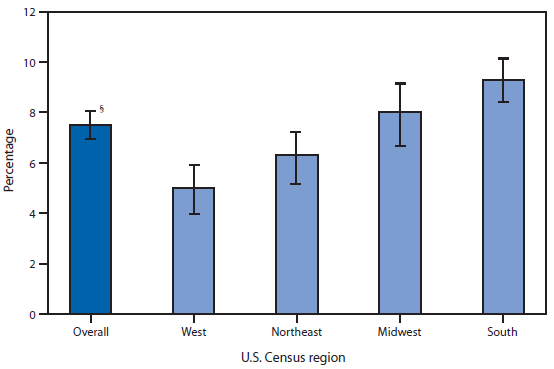QuickStats: Percentage of Children Aged 6–17 Years Prescribed Medication During the Preceding 6 Months for Emotional or Behavioral Difficulties,* by Census Region — National Health Interview Survey,† United States, 2011–2012

* Based on responses to the question, "During the past 6 months, was [child's name] prescribed medication or taking medication for difficulties with emotions, concentration, behavior, or being able to get along with others."
† Estimates are based on household interviews of a sample of the noninstitutionalized, civilian U.S. population and are derived from the National Health Interview Survey sample child component.
§ 95% confidence interval.
During 2011–2012, among children aged 6–17 years, 7.5% overall had been prescribed medication for emotional or behavioral difficulties during the preceding 6 months. By U.S. Census region, the percentages were 9.3% in the South, 8.0% in the Midwest, 6.3% in the Northeast, and 5.0% in the West.
Source: National Health Interview Survey, 2011–2012. Available at http://www.cdc.gov/nchs/nhis.htm.
Reported by: LaJeana D. Howie, MPH, lhowie@cdc.gov, 301-458-4611; Patricia N. Pastor, PhD; Susan L. Lukacs, DO.
Alternate Text: The figure above shows the percentage of children aged 6-17 years prescribed medication during the preceding 6 months for emotional or behavioral difficulties, by U.S. Census region, in the United States during 2011-2012. Among children aged 6-17 years, 7.5% overall had been prescribed medication for emotional or behavioral difficulties. By U.S. Census region, the percentages were 9.3% in the South, 8.0% in the Midwest, 6.3% in the Northeast, and 5.0% in the West.
Use of trade names and commercial sources is for identification only and does not imply endorsement by the U.S. Department of
Health and Human Services.
References to non-CDC sites on the Internet are
provided as a service to MMWR readers and do not constitute or imply
endorsement of these organizations or their programs by CDC or the U.S.
Department of Health and Human Services. CDC is not responsible for the content
of pages found at these sites. URL addresses listed in MMWR were current as of
the date of publication.
All MMWR HTML versions of articles are electronic conversions from typeset documents.
This conversion might result in character translation or format errors in the HTML version.
Users are referred to the electronic PDF version (http://www.cdc.gov/mmwr)
and/or the original MMWR paper copy for printable versions of official text, figures, and tables.
An original paper copy of this issue can be obtained from the Superintendent of Documents, U.S.
Government Printing Office (GPO), Washington, DC 20402-9371;
telephone: (202) 512-1800. Contact GPO for current prices.
**Questions or messages regarding errors in formatting should be addressed to
mmwrq@cdc.gov.


